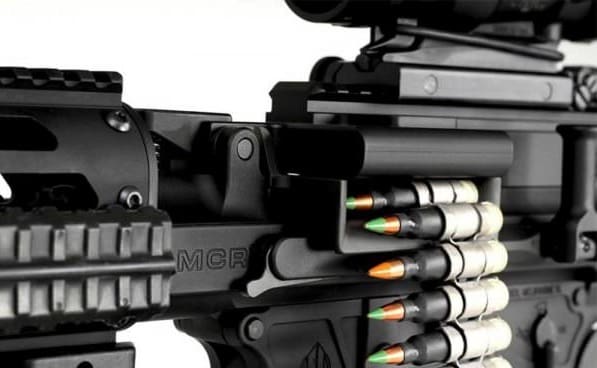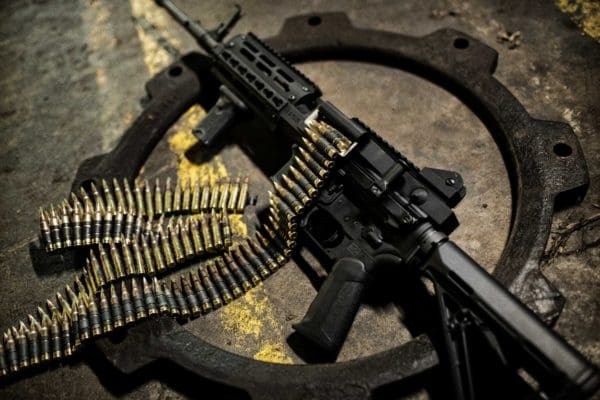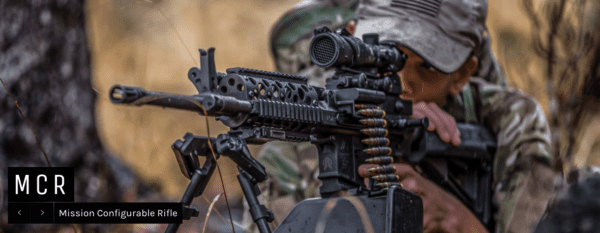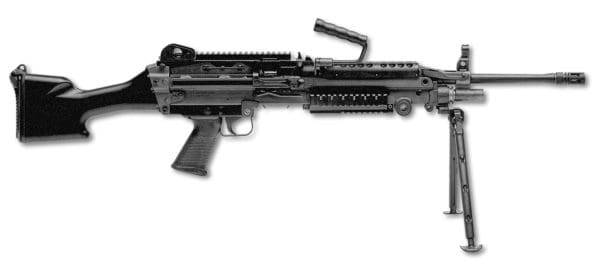When it comes to military gear, lighter is generally better. Mobility is the name of the game. FightLite gets it. They’re pairing their lightweight automatic rifle with polymer cased ammunition to further relieve the physical burden on our men and women fighting on the front lines.
FightLite’s belt-fed firearm was designed in 2002, marketed as the SHRIKE upper receiver. The rifle allows AR-15 owners to use standard magazines or linked belts of 5.56 ammunition on their existing lower receiver.
The biggest benefit was for machine gun owners: those with a [registered] full auto lower receiver could have both a belt-fed rifle and their existing machine gun with no extra paperwork. Production was slow to ramp-up and unit costs remained high ($4,414 per upper receiver). Very few SHRIKEs made it into the wild.
FightLite is now trying to sell their weapon system to the government as a lightweight replacement for existing automatic weapons, paired with a new polymer ammunition (presser).
The ammo appears to be the same as the PCP Ammunition we reviewed some three years ago, in 5.56 NATO (not 7.62 NATO). The polymer case reduces total ammo weight by a reported 20 percent — doing nothing to lighten the actual projectile.
Anyway, at $4,450 FightLite’s complete MCR (Mission Configurable Rifle) rifle with its belt-fed upper is a steal — only $45 more than the cost of the upper alone.
At a full 10 pounds lighter than the M249 SAW (above) it seeks to replace, the MCR is better on paper. Lighter, cheaper with better parts compatibility to firearms in use by the same squad, it’s a logical step.
One critical, unanswered question: is the MCR is reliable enough for military use?
With its usual efficiency [/sarc], the U.S. military is ramping-up its replacement program for the rifles and automatic weapons. It might be a good time for FigheLite’s MCR to get its foot in the door. Watch this space.








I remember reading about Polycase (inventor of the Ruger ARX round) and they were getting into polymer ammunition because the cases are not reusable. I know in the logistics of war distribution of weapons isn’t usually the problem, it’s the ammunition. They claimed that insurgents would police the brass of their enemy and reload them to use against them, polymer cases make that impossible.
Col. Berdan had a solution for this a long time ago.
You can reload Berdan primed rounds. You just have to be creative to de-cap the cases.
7.62×25 Tokarev is apparently popular in places with NATO forces because you can make it from 5.56 brass (which NATO forces just leave lying around)
Citation?
Not that I don’t believe you, that just sounds really interesting and I want to know more…
I can’t give you a citation, but knowing their dimensions I see no reason why this can’t be done, with good results. The increased web thickness of the 5.56NATO case would be ideal for the higher pressured Tok.
Now that I think of it, this practice would be extremely similar to creation of the 22TCM.
Look up “Converting .223(5.56) brass into 7.62×25 Tokarev TT-33 brass.” on youtube.
My copy of Handloaders Manual of Cartridge conversions lists this for 7.62 TOK:
“Make From: .38 Special. Turn rim to .390″ diameter, Trim to .98″ F/L size, Final trim to length. .223 Rem brass may also be used by cutting to length and F/L sizing but you’ll need to I.D. neck ream.”
That may have been an issue in previous conflicts, but not the ones the US is currently engaged in. Our opposition’s ammo caches were massive. Even in southern Afghanistan, our small team found a cache of 5,000 .51 caliber DsHk rounds under a floor in a home, and smaller caches were common. There was never a shortage of explosives or ammunition used by the enemy. We often noted that these guys must wake up and crap RPGs.
I don’t understand. Both the “Dashka” and the M2 fire projectiles of 12.7mm diameter, only case length differs.
Why would there be a difference in caliber ?
I can say with good certainty that bad guys reloading brass isn’t a concern
exactly
My initial questions are: will it work with normal brass ammunition (ie can is switch back an forth), what is the range in comparison to a SAW, how controllable is it on full auto with the reduced weight of the gun and would it work with the 6.5 that is being toyed with.
Full-auto is not generally the best use of a weapon. The direction for research needs to be for smart sights that can identify hostiles and fire at them in single-shot mode. There would still be some need for user discretion in the selection of targets, but the sights could become better than humans at separating friend from foe.
Full auto is certainly the best use of a belt fed weapon, and preferably in pairs with interlocking fields of fire.
Full auto is the best use for a weapon that’s a Machine Gun. Full auto fire is what it’s designed for. This is seeking to replace the SAW, not m4.
I completely understand the need to have non reloadable casings but haven’t warmed up to plastic just yet considering previous articles here, but it always bugged me having kids picking up brass knowing it will soon be hammered back to life in a shed and there pretty good at improvising so who knows plastic casing might still be reloadable it can withstand the pressures after all
HOT!
I mean, I bet it gets crazy hot.
Yeah, the closed bolt operation seems like it would hold it back from overtaking the SAW. I mean, maybe with polymer cased ammo it won’t transfer heat as easily and the danger of cook offs is reduced? Won’t that also run the risk of melting the case? I’m always leery about someone turning a rifle into a real deal machine gun. At least it has quick change barrels.
As I understand it, a good amount of heat removal from a rifle comes in the form of ejected hot brass. For a machine gun I presume it’s even more important.
So I wonder both about heat removal via the plastic cases, and also if there’s any problems with chambered rounds melting or deforming if left in a hot chamber.
Maybe the polymer would prevent much of that heat energy from transferring to the chamber in the first place? I really dunno, just a thought.
I’ve never been a fan of the SAW. I found it to be prone to failures and never very accurate. We gave our to our terps. I’d want to see how the MCR does with sustained fire at 600 meters and farther. As it is, I’d take a 240G over either of them.
What’s your criteria for “accurate?” Or is it just more of a general feeling?
I has to be different for each platform, but for a squad manned light automatic weapon I would want it to reliably strike a 19″ target at 500 meters.
Wha? It can’t do that, with optics? A buddy of mine from highschool was a combat engineer and he was the driver, so had the 249 assigned to him. He loved it and said it could hit out to 800 yards. I’m assuming there is a big variance in capability depending on how the piece is maintained and the battlefield conditions you are in.
Hit something? Sure. But a man sized target, no, I never saw any of them with that kind of accuracy. Its big brother, the 240, was always much more accurate and reliable. Again, we considered the SAW so worthless that we gave it to the terps to make them feel like part of the team.
Not that 240s go down that much but what was your back up/local area suppression plan. I much prefer the 240 but I still can’t imagine giving a suppression weapon to a interpretor.
Cheep plastic ammo is the way of the future and save troops from carrying a ton of weight. The standard issue was nine 30 rounders up from seven and who knows if that’s gone up again in the last few years. I don’t have a lot of faith in the manufacturer PCP Ammunition all the same.
You don’t actually believe that grunts will get their load lighter, do you? I bet they will just carry more ammo or something else at least as heavy as any weight savings the plastic cartridge cases or lighter gun will allow.
plastic seems too brittle for this application. we use brass because it flexes and stretches with out cracking mostly. i just can’t imagine a hardened plastic doing that well but who knows. Technology changes everything.
Comments are closed.